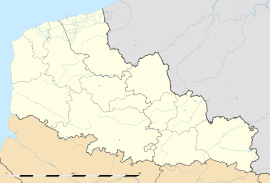Laires
| Laires | |
|---|---|
 Laires | |
|
Location within Nord-Pas-de-Calais region  Laires | |
| Coordinates: 50°32′28″N 2°15′23″E / 50.5411°N 2.2564°ECoordinates: 50°32′28″N 2°15′23″E / 50.5411°N 2.2564°E | |
| Country | France |
| Region | Nord-Pas-de-Calais |
| Department | Pas-de-Calais |
| Arrondissement | Saint-Omer |
| Canton | Fauquembergues |
| Intercommunality | Communauté de communes du Canton de Fauquembergues |
| Government | |
| • Mayor | Bernadette Franche |
| Area | |
| • Land1 | 8.64 km2 (3.34 sq mi) |
| Population (2006) | |
| • Population2 | 306 |
| • Population2 Density | 35/km2 (92/sq mi) |
| INSEE/Postal code | 62485 / 62960 |
| Elevation |
140–190 m (460–620 ft) (avg. 182 m or 597 ft) |
|
1 French Land Register data, which excludes lakes, ponds, glaciers > 1 km² (0.386 sq mi or 247 acres) and river estuaries. 2 Population without double counting: residents of multiple communes (e.g., students and military personnel) only counted once. | |
Laires is a commune in the Pas-de-Calais department in the Nord-Pas-de-Calais region of France.
Geography
A village situated 15 miles (24 km) south of Saint-Omer, on the D95 road.
Its surrounded by the common Beaumetz-lès-Aire, Erny-Saint-Julien and Laires. Bomy is located 19 km southwest of Saint-Omer's largest city around.[1]
Population
| Year | 1962 | 1968 | 1975 | 1982 | 1990 | 1999 | 2006 |
|---|---|---|---|---|---|---|---|
| Population | 335 | 347 | 302 | 314 | 337 | 297 | 306 |
| From the year 1962 on: No double counting—residents of multiple communes (e.g. students and military personnel) are counted only once. | |||||||
History
In 734, Laires was called "Wilbert", after its owner. The spelling of the name has changed over the centuries from Larae, Laris, Lares, Laire and Lare, to become Laires by the eighteenth century. In 1115, Baldwin VII, Count of Flanders, made a gift of the village to the abbey of St Saviour at Ham. In January 1478, a band of soldiers from the Burgundian garrison at Renescure terrorized the area around Laires. Instead of helping people to fight the "French enemy" they looted the village. Against the Spanish, the commune suffered again. In 1537 the area was completely devastated. In 1542 and 1543, the village was looted several times and fourteen French houses were burned down.
Places of interest
- The church of St.Martin, dating from the fifteenth century.
- The war memorial, from 1921.
See also
References
External links
| Wikimedia Commons has media related to Laires. |
- Laires on the Quid website (French)